Decarboxylation Study guides, Class notes & Summaries
Looking for the best study guides, study notes and summaries about Decarboxylation? On this page you'll find 226 study documents about Decarboxylation.
Page 3 out of 226 results
Sort by
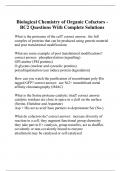
-
Biological Chemistry of Organic Cofactors - BC2 Questions With Complete Solutions
- Exam (elaborations) • 8 pages • 2023
-
- $10.99
- + learn more
What is the proteome of the cell? correct answer: the full complex of proteins that can be produced using genetic material and post translational modifications What are some example of post translational modifications? correct answer: phosphorylation (signalling) GPI anchor (PM proteins) O-glycans (nuclear and cytosolic proteins) polyubiquitination (can induce protein degredation) How can you watch the purification of recombinant poly-His tagged GFP? correct answer: use Ni2+ immobili...
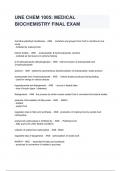
-
UNE CHEM 1005: MEDICAL BIOCHEMISTRY FINAL EXAM QUESTIONS AND ANSWERS
- Exam (elaborations) • 2 pages • 2024
- Available in package deal
-
- $7.99
- + learn more
UNE CHEM 1005: MEDICAL BIOCHEMISTRY FINAL EXAM QUESTIONS AND ANSWERS Carnitine palmitoyl transferase - ANS - transfers acyl groups from CoA to carnitine & vice versa - inhibited by malonyl-CoA ketone bodies - ANS - acetoacetate, β-hydroxybutyrate, acetone - oxidized as fuel source in extreme fasting d-3-hydroxybutyrate dehydrogenase - ANS interconversion of acetoacetate and 3-hydroxybutyrate acetone - ANS yielded by spontaneous decarboxylation of acetoacetate; was...
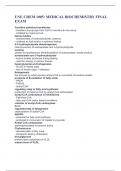
-
UNE CHEM 1005: MEDICAL BIOCHEMISTRY FINAL EXAM
- Exam (elaborations) • 2 pages • 2023
- Available in package deal
-
- $9.49
- + learn more
UNE CHEM 1005: MEDICAL BIOCHEMISTRY FINAL EXAM Carnitine palmitoyl transferase - transfers acyl groups from CoA to carnitine & vice versa - inhibited by malonyl-CoA ketone bodies - acetoacetate, β-hydroxybutyrate, acetone - oxidized as fuel source in extreme fasting d-3-hydroxybutyrate dehydrogenase interconversion of acetoacetate and 3-hydroxybutyrate acetone yielded by spontaneous decarboxylation of acetoacetate; waste product acetoacetate and 3-hydroxybutyrate - ketone bodies p...
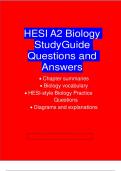
-
HESI A2 Biology Study Guide Questions and Answers
- Exam (elaborations) • 48 pages • 2023
-
Available in package deal
-
- $15.39
- + learn more
HESI A2 Biology Study Guide Questions and Answers Cellular respiration is the process inside of cells that converts nutrients (such as sugars, amino acids, and fatty acids) into ATP (adenosine triphosphate), which is used throughout the organism for energy. Large molecules are broken into smaller molecules, which releases both energy and waste. Aerobic respiration occurs in the presence of Oxygen and has four main stages: • Glycolysis: Larger sugar molecule is broken down into 2 smaller sug...

-
NAS Exam 2 Final Questions and Answers Latest Verified 2024
- Exam (elaborations) • 12 pages • 2024
-
- $14.99
- + learn more
NAS Exam 2 Final Questions and Answers Latest Verified 2024 why is chemical energy needed by cells? - CORRECT ANSWER-to maintain homeostasis Define cell respiration - CORRECT ANSWER-the mechanism for harvesting energy from fuel molecules; the oxidation of glucose to produce ATP what is the function of the reduced coenzymes? - CORRECT ANSWER-They are used to transfer energy to another compound Describe the function of oxidation-reduction reactions in the synthesis of ATP. - CORRECT A...
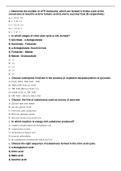
-
Biochemistry usmle step 1 2023 questions and answers
- Exam (elaborations) • 69 pages • 2023
- Available in package deal
-
- $19.49
- + learn more
1. Determine the number of ATP molecules, which are formed in Krebs cycle at the conversion of isocitric acid to fumaric acid (I) and to succinyl CoA (II) respectively: A) I -7,0; II - 5,5 B) I - 5; II - 3,5 C) I - 6,5; II - 4,5 D) I - 7,5; II - 5 E) I - 7; II - 3 2. In which stages of citric acid cycle is CO2 formed? 1) Izocitrate - α-Ketoglutarate 2) Succinate - Fumarate 3) α-Ketoglutarate -Succinil-CoA 4) Fumarate – Malate 5) Malate –Oxaloacetate A) 1,3 B) 2,4 C) 1,4 D) ...
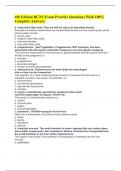
-
4th Edition BCNS Exam Practice Questions With 100% Complete Answers.
- Exam (elaborations) • 29 pages • 2024
-
- $18.99
- + learn more
4th Edition BCNS Exam Practice Questions With 100% Complete Answers. d. long-chain fatty acids They are still too big to be absorbed directly Examples of dietary nutrients that are not absorbed directly into the enterohepatic portal blood system include: a. amino acids. b. medium-chain fatty acids. c. monosaccharides. d. long-chain fatty acids. b. progesterone. "gest"=gestation. Progesterone, NOT estrogen, has been associated with decreased contraction frequency and slow gastric empty...
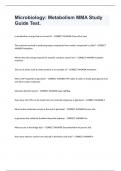
-
Microbiology: Metabolism MMA Study Guide Test.
- Exam (elaborations) • 3 pages • 2024
-
Available in package deal
-
- $10.99
- + learn more
Microbiology: Metabolism MMA Study Guide Test. In metabolism, energy that is not used is? - CORRECT ANSWER Given off as heat The reactions involved in producing larger compounds from smaller compounds is called? - CORRECT ANSWER Anabolism Where does the energy required for anabolic reactions come from? - CORRECT ANSWER Catabolic reactions The use of amino acids to make proteins is an example of? - CORRECT ANSWER Anabolism Why is ATP required for glycolysis? - CORRECT ANSWER ATP ...
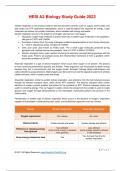
-
HESI A2 Biology Study Guide 2023
- Exam (elaborations) • 47 pages • 2023
-
- $10.99
- + learn more
HESI A2 Biology Study Guide 2023 Cellular respiration is the process inside of cells that converts nutrients (such as sugars, amino acids, and fatty acids) into ATP (adenosine triphosphate), which is used throughout the organism for energy. Large molecules are broken into smaller molecules, which releases both energy and waste. Aerobic respiration occurs in the presence of Oxygen and has four main stages: Glycolysis: Larger sugar molecule is broken down into 2 smaller sugar molecules in...
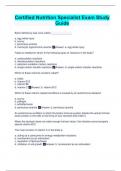
-
Certified Nutrition Specialist Exam Study Guide
- Exam (elaborations) • 10 pages • 2024
-
Available in package deal
-
- $10.49
- + learn more
Biotin deficiency was once called _______________. a. egg white injury b. scurvy c. pernicious anemia d. microcytic hypochromic anemia Answer: a. egg white injury Folate is needed for which of the following types of reactions in the body? a. carboxylation reactions b. decarboxylation reactions c. reduction-oxidation (redox) reactions d. single-carbon transfer reactions Answer: d. single-carbon transfer reactions Which of these vitamins contains cobalt? a. folate b. vitamin ...

How did he do that? By selling his study resources on Stuvia. Try it yourself! Discover all about earning on Stuvia


